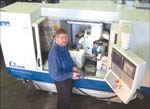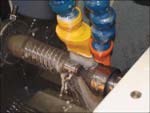Published
CNC Grinder Helps Start A Business
This Cleveland grinding shop owner discusses the challenges and rewards of starting a business in downtimes, and what it takes to stay competitive.
Share





With the economy beginning to head south, many manufacturers were searching for ways to cut costs during the late 1990s. To many, this would seem to be an inopportune time to start a niche grinding business. However, viewing the proverbial glass as being half full, Joe Scolaro saw this period as a window of opportunity.
At the time, Mr. Scolaro was a manufacturing department supervisor at a Cleveland plant, and he felt he'd "hit the ceiling" as far as potential for career advancement. He met a machinery dealer who had a used manual Studer from United Grinding (Miamisburg, Ohio) on his floor. Mr. Scolaro bought it, leased a 2,500 square-foot space, and, along with partner Dale Stebner, began knocking on doors. Thus began Venture Grinding, Inc. (Cleveland, Ohio).
Since that first used manual Studer 6 years ago, Mr. Scolaro and Mr. Stebner have bought three others—an S21, an S36 and the latest model, the S31 with a full B axis, which permits combining several operations in one chucking.
Mr. Scolaro says he started Venture Grinding to fill a niche. "Most machine shops don't have a grinding department," he says. "They do extensive turning and milling, but when it comes to grinding, most send the job out, primarily because grinding is a specific and highly variable discipline. Hardness, grit size, makeup, the dressing method and coolant are among the many aspects to be considered.
"You can teach programming relatively easily, but in a grinding operation, you must take your eyes and ears out on the floor," he continues. "Listening and feeling for vibration can indicate how a part is running. For instance, the operator can ascertain if the wheel is too hard, if the part is getting too warm or if the coolant concentration needs to be modified.
"I don't want to call grinding an art form, but there's certainly more involved in finishing a ground part than in turning or milling a part," Mr. Scolaro adds.
According to Mr. Scolaro, the last 4 years have been rough. A lot of shops Venture Grinding's size and larger have not survived. The companies that have remained, the OEMs and the bigger machine shops, have had to make every possible effort to reduce costs.
"I knew someone was still going to be making small lots of complex parts, and we stepped up our sales efforts and won jobs," Mr. Scolaro says. "Being a startup, leasing shop space, having the best machines and having low overhead, we were able to give customers a more competitive price. Sometimes we were offering same-day turnaround to get the business. That's something that companies who went overseas with their parts gave up—quick response."
One of the many factors Venture Grinding attributes to its success is the communication between the company and its customers. Mr. Scolaro explains that, in most cases, grinding is the last in a series of several operations. For instance, many jobs the company receives are from heat-treating operations. If the upstream processes fall behind in schedule, it's difficult for the company to make up the difference.
"We try to maintain a schedule, while still being flexible," Mr. Scolaro says. "If we get an order with a few days notice, it's not a problem. Because of the flexibility and reliability of the Studer machines, we can run jobs as small as two pieces to lots comprised of as many as 10,000 pieces." The Studer pictogramming and the quick-set programming feature makes rotating the B axis; maintaining the relationship between the wheels and the part; and change-over, setup and training relatively easy.
Another strategic tip Mr. Scolaro offers is the 20 percent rule. He says he tries to never have more than 20 percent of his work tied to one customer; in fact, 20 percent makes him nervous. It's not that the company turns away large orders, but it continues to look for new customers so that it is never in a position where there will be serious problems if a customer sends work overseas.
Currently, Mr. Scolaro says the company has about 16 or 17 percent of its work tied to one customer. However, he notes that taking this percentage rule too far in the other direction—for example, having less than 4 percent or 5 percent tied to each—would be unfeasible. "It would be impossible to keep track of who was doing what for whom and when, which would make scheduling problematic," explains Mr. Scolaro.
A corollary to the percentage rule is having a diverse customer base. The company's original goal was to reach out to customers with high-tech applications, complex grinding jobs requiring a variety of materials and tight tolerances. Venture's customer base ranges from aerospace to medical to tooling components. Challenging jobs allow the company to use the depth of its resources and experience.
Venture Grinding is currently running a worm gear that is 1.250 inches in diameter and 6.0 inches in length. It has a thread-ground center area, and the journals have to be held to 0.0004 inch. The gear is run on the S31, with the B axis and the ID and OD ground in one chucking. This is said to ensure concentricity and gearbox performance.
"Generally, the tolerances we work with are in the 0.0002-inch to 0.0003-inch diameter range," says Mr. Scolaro.
A second part Mr. Scolaro mentions is a toolholder. "The company makes toolholders in various types and configurations," he says, "and the relationship between the OD and the ID taper is always critical." A specific feature of the part is clamped on the OD. This is followed by OD grinding; the ID wheel is indexed; and grinding the ID taper then occurs. "This happens all in one clamping," notes Mr. Scolaro "which results in an accurate relationship between the OD and the ID taper."
This can be particularly important today because many of these toolholders are being applied in rotating applications. This means that concentricities have become increasingly tighter, to the point that they could not have been achieved by previous conventional methods, which required multiple fixturings and part handling.
Mr. Scolaro offers this final bit of strategic advice: Stick with your core competency; outsource the other stuff.
The other "stuff" Scolaro refers to include things such as payroll, accounts payable, accounts receivable, invoicing, taxes and so on. He says Venture tried to handle these things internally for awhile, but it proved not to be very good at them. So, like its customers, the company looked outside for these services.
Mr. Scolaro says such outsourcing not only makes good strategic sense, but it also frees him and his partner to do what they do best: make parts, keep in touch with customers and call on new prospects. It's also cost effective. "My book keeper can do all these things in less than half of the time it would take me," Mr. Scolaro says, "and that translates into considerable savings—to say nothing of alleviating us of some huge headaches."
"Grinding technology took a serious leap forward about 5 to 7 years ago," says Mr. Scolaro. "CNC took hold, the machines became more flexible and you could do machine operations that previously required multiple setups, machines and operators on one. Before that, the conventional wisdom was to run small quantities on manual machines because they were easy to set up, to change-over and to run. Today I can program and run a part faster on my CNC Studers than I ever could on a manual machine."
Read Next
Registration Now Open for the Precision Machining Technology Show (PMTS) 2025
The precision machining industry’s premier event returns to Cleveland, OH, April 1-3.
Read More5 Rules of Thumb for Buying CNC Machine Tools
Use these tips to carefully plan your machine tool purchases and to avoid regretting your decision later.
Read More
Workforce Development
Building Out a Foundation for Student Machinists
Autodesk and Haas have teamed up to produce an introductory course for students that covers the basics of CAD, CAM and CNC while providing them with a portfolio part.
Read More














.jpg;maxWidth=300;quality=90)


.jpg;maxWidth=300;quality=90)















